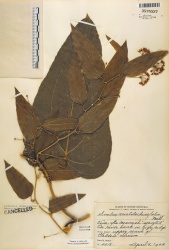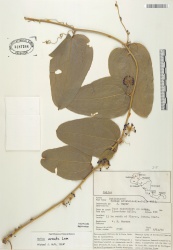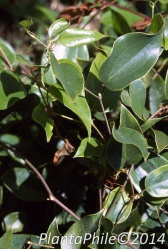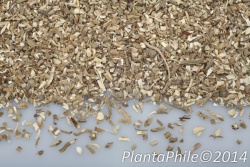Smilax aristolochiifolia (root)
(add USD 1918 information (macroscopic/microscopic)) |
(→images removed for updating on request via PF from contributer) |
||
| (2 intermediate revisions by one user not shown) | |||
| Line 40: | Line 40: | ||
The Mexican or Vera Cruz sarsaparilla is derived from this species. ... [The roots] consist of a head or caudex with numerous long radicles, which, however, are somewhat smaller than in that variety, and have a thinner bark. They are often also much coiled with earth. It contains but little starch and has quadrangular endodermal cells, with thickened walls, and more or less oval lumen.}} | The Mexican or Vera Cruz sarsaparilla is derived from this species. ... [The roots] consist of a head or caudex with numerous long radicles, which, however, are somewhat smaller than in that variety, and have a thinner bark. They are often also much coiled with earth. It contains but little starch and has quadrangular endodermal cells, with thickened walls, and more or less oval lumen.}} | ||
| + | |||
| + | {{ Media2 | cat=Macroscopy | ||
| + | | source=PlantaPhile | ||
| + | | mainimage=PlantaPhile - 1409.jpg | ||
| + | | companyimage=PlantaPhile logo.jpg | ||
| + | | companyURL=http://plantaphile.com/ | ||
| + | |||
| + | | source2=PlantaPhile | ||
| + | | image2=PlantaPhile - 3053.jpg | ||
| + | | companyimage2=PlantaPhile logo.jpg | ||
| + | | companyURL2=http://plantaphile.com/ | ||
| + | | }} | ||
|} | |} | ||
| Line 47: | Line 59: | ||
| | | | ||
{{Macroscopy | source=United States Dispensatory (1918) | {{Macroscopy | source=United States Dispensatory (1918) | ||
| − | | description=Under the microscope, transverse sections of all of the commercial varieties of Sarsaparilla show an epidermal layer with basal portions of root hairs; a hypodermis composed of several layers of strongly lignified cells, the walls being uniformly thickened, except in Mexican Sarsaparilla in which the inner walls are only slightly thickened; a cortex composed of numerous parenchyma cells mostly containing starch, some containing resin or raphides of calcium oxalate; an endodermis of a single layer of strongly lignified cells, the walls being' uniformly thickened except in Mexican Sarsaparilla in which the outer walls are only slightly thickened; a central cylinder composed of radial bundles connected with sclerenchymatous fibers, the tracheas being large and oval and the phloem in small groups at the periphery of the bundle; and a pith composed of starch-bearing parenchyma cells. | + | | description=Under the microscope, transverse sections of all of the commercial varieties of Sarsaparilla show an epidermal layer with basal portions of root hairs; a hypodermis composed of several layers of strongly lignified cells, the walls being uniformly thickened, except in Mexican Sarsaparilla in which the inner walls are only slightly thickened; a cortex composed of numerous parenchyma cells mostly containing starch, some containing resin or raphides of calcium oxalate; an endodermis of a single layer of strongly lignified cells, the walls being' uniformly thickened except in Mexican Sarsaparilla in which the outer walls are only slightly thickened; a central cylinder composed of radial bundles connected with sclerenchymatous fibers, the tracheas being large and oval and the phloem in small groups at the periphery of the bundle; and a pith composed of starch-bearing parenchyma cells. |
| − | + | Powdered Sarsaparilla is light grayish-brown to dark grayish-brown; when examined under the microscope it exhibits numerous starch grains, from 0.003 to 0.023 mm. in diameter, spherical, or biconvex or spherical-tetrahedral, single to 2- to 4-compound, and frequently with a central-elliptical cleft; calcium oxalate in raphides, from 0.006 to 0.035 mm. in diameter, occurring singly or in groups; cells of the hypodermis and endodermis with lemon-yellow or reddish-yellow porous walls and, in the case of Mexican Sarsaparilla, showing an uneven or irregular thickening, the individual cells from 0.08 to 0.5 mm. in length; fragments of trachea) with simple and bordered pores or scalariform or reticulate thickenings associated with sclerenchymatous fibers having rather thin, very slightly lignified and porous walls. }} | |
| − | + | ||
| − | + | ||
| − | + | ||
| − | + | ||
| − | + | ||
| − | + | ||
| − | + | ||
| − | + | ||
| − | + | ||
| − | + | ||
| − | + | ||
|} | |} | ||
Latest revision as of 17:52, 15 October 2020
Contents |
Nomenclature
Smilax aristolochiifolia Mill. Smilacaceae
Syn. Smilax medica Schltdl. & Cham.; Smilax ornata Lem.
Standardized common name (English): sarsaparilla
Botanical Voucher Specimen
|
|
|
Organoleptic Characteristics
Macroscopic Characteristics
|
Microscopic Characteristics
|
High Performance Thin Layer Chromatographic Identification
Supplementary Information
Sources
- ↑ MOBOT, Tropicos.org http://www.tropicos.org/Image/26042
- ↑ MOBOT, Tropicos.org http://www.tropicos.org/Image/27626
- ↑ United States Dispensatory (1918)
- ↑ PlantaPhile http://plantaphile.com/
- ↑ PlantaPhile http://plantaphile.com/
- ↑ United States Dispensatory (1918)



